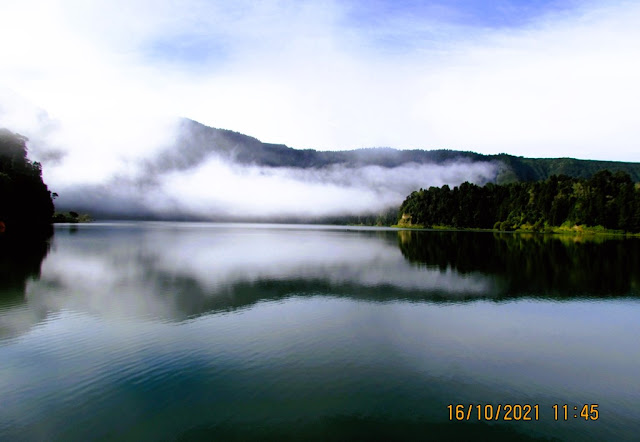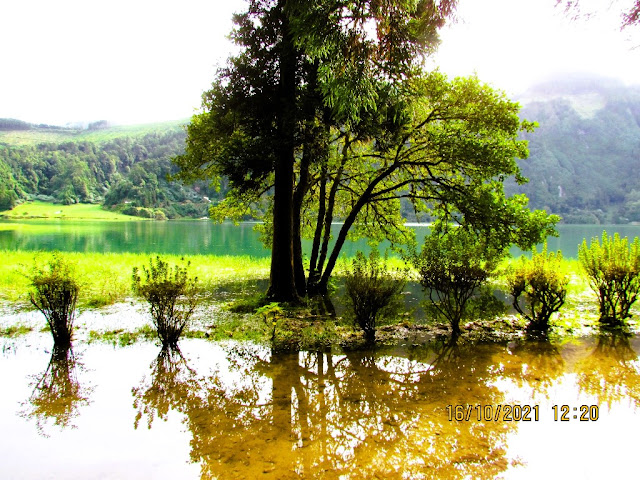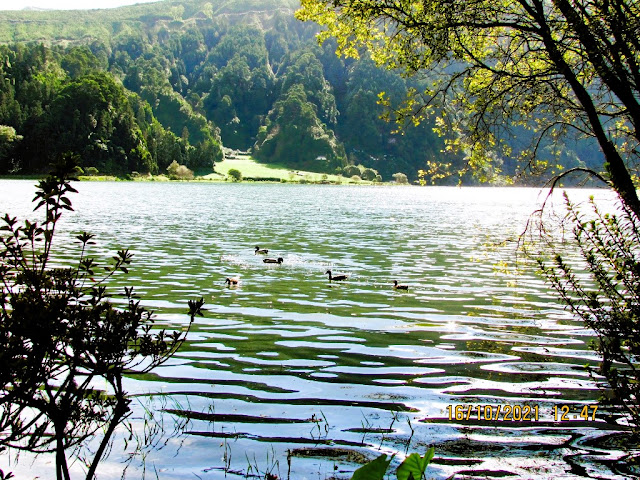LAGOA DAS SETE CIDADES
37.85495, -25.78485
Lagoa das Sete Cidades is a twin lake situated in the crater of a dormant volcano on the Portuguese archipelago of the Azores. It is made by two small, ecologically different lakes connected by a narrow strait, crossed by a bridge. The volcano is located on the western third of the island of São Miguel. The Lagoa das Sete Cidades is part of a natural landscape of communitarian interest: it is the largest body of water in the region and one of the most important freshwater resources in the archipelago.
Geography
The lake is situated within the caldera of the Sete Cidades Massif, an ancient volcano built on various layers of ash, pyroclasts, and trachyte and basaltic lavas. It is a stratovolcano constructed from alternating phases of explosive and effusive ejecta, from dominantly basaltic pre-caldera eruptions, a trachytic caldera-forming stage, and a post-caldera stage consisting of alternating trachytic and basaltic eruptions. The caldera-forming eruption was triggered by a basaltic injection into a shallow trachytic magma chamber.
These geomorphological structures allowed varying hydrochemical properties and produced many types of springs and water circulation networks. Generally, formations with good hydrodynamic properties include areas with lava flows, basaltic pyroclasts and/or pumice, while solidified ignimbrites, conditioned by high temperatures and paleosols, such as ash, have produced impermeable conditions. The aquifers are dependent on reduced permeability, or secondary volcanoes with hydrogeologically significant volumes. Consequently, the accumulation of ash at the bottom of the craters and caldera has conditioned the formation of lakes.
Although, hydrologically, the Lagoa das Sete Cidades is one lake, most refer to it as two separate bodies: Lagoa Verde and Lagoa Azul. Literally, the Green Lake and the Blue Lake (respectively), they are so named because each side of the lake reflects the sunlight in different colors.
Human impacts
In the middle of the twentieth century, the destruction of forested areas in the natural catchment area of the lake, and their transformation into grassland and pasture, increased the runoff of nutrients, particularly phosphorus and nitrogen, from the steep land. Lacking a domestic sewage system until recently, the community of Sete Cidades contributed to gradual pressures on the ecosystem, resulting in an overabundant development of rooted aquatic macrophytes and algae in the water bodies. The eutrophication of the Lagoa das Sete Cidades lakes, due to nutrient enrichment enhanced by human agricultural and domestic activities, began to be noticed in 1987 and led to the implementation of a monitoring program. Measurements are taken at the time, which included the examination of Carlson's Trophic state index, the measure of chlorophyll, inorganic nitrogen, and phosphorus in the water column were made, showing increases in all measures. While phytoplankton populations varied throughout the year in the Lagoa Azul, the presence of phytoplankton in the Lagoa Verde persisted annually, dominated by cyanobacteria. When temperature, light, and nutrient availability are adequate to phytoplankton growth, surface waters may host algae or cyanobacteria blooms. In eutrophic waters, cyanobacteria often dominate the summer and early autumn phytoplankton, while during winter and spring, they are replaced by diatoms.
As the existence of a eutrophication process in Sete Cidades Lake was already known since the 1980s, the rise of cyanobacteria blooms was not unexpected by 2000. Although the average total phosphorus concentration inside the lake was not very high, concentrations found in winter samples proved that there was an important runoff of fertilized water from the watershed. High levels of cyanotoxins were found in 2002 in Blue Lake. Lake water within the watershed is not potable, but for recreational use, like swimming and windsurfing, were common practices. Advisories were placed along the lakes to warn of bloom toxicity and associated health dangers.
💝💝💝💝💝
INDEX
Search in São Miguel Island & Azores
😍😍😍😍 - AZORES ISLANDS
💟💟💟 - São Miguel Island
🔟🔟🔟🔟 - Must-see attractions
💙💙💙💙 - Municipalities
💙💙 - Parishes
Municipalities and Parishes
Sao Miguel Island
AZORES ISLANDS
🙆🙆🙆🙆🙆🙆🙆🙆🙆🙆
🙆🙆🙆🙆🙆🙆🙆🙆🙆🙆
Return to the Index
INDEX
Search in São Miguel Island & Azores
😍😍😍😍 - AZORES ISLANDS
💟💟💟 - São Miguel Island
🔟🔟🔟🔟 - Must-see attractions
💙💙💙💙 - Municipalities
💙💙 - Parishes
Municipalities and Parishes
Sao Miguel Island
AZORES ISLANDS
Return to mainland Portugal and
to the Azores and Madeira islands






































































No comments:
Post a Comment